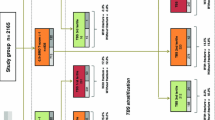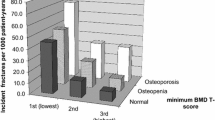Abstract
Summary
Trabecular bone score (TBS) enhances fracture risk assessment in older adults; whether this is true in younger people is uncertain. In this registry-based study of adults aged 20–39 years, low BMD, but not low TBS, predicted fracture.
Purpose
Trabecular bone score (TBS), a bone texture measurement, is associated with fracture risk independent of bone mineral density (BMD) in older adults. In adults aged 20–40 years, TBS remains stable and its role in fracture risk assessment is unclear. We utilized the Manitoba Bone Density Registry to explore the relationship of fracture risk with BMD and TBS in younger adults.
Methods
Women and men aged 20–39 years referred for DXA testing were studied. Incident major and any fractures were captured from health records. Categories based on WHO BMD T-score classification and TBS tertile were considered using Cox regression models to estimate covariate-adjusted (including sex) hazard ratios (aHR, 95%CI) for incident fracture by category, and each SD decrement in BMD and TBS.
Results
The study included 2799 individuals (77% female, mean age 32 years). Mean (SD) minimum T-score was − 0.9 (1.1) and TBS 1.355 (0.114); 7% had osteoporosis and 13% were in the lowest TBS tertile. Incident major osteoporotic fracture (MOF) and any fracture risk was elevated in those with osteopenia (aHRs 1.20/1.45) and osteoporosis (aHRs 4.60/5.16). Fracture risk was unrelated to TBS tertile. Each SD decrement in BMD was associated with increased MOF risk (aHR 1.64) and any fracture (aHR 1.71); lower TBS was unrelated to fractures.
Conclusion
In young adults, low BMD, but not low TBS, was predictive of MOF and any fracture. Routine clinical TBS measurement is not recommended for young adults. Further study is indicated to evaluate whether TBS is beneficial in subsets of younger adults.

Similar content being viewed by others
References
Silva BC, Leslie WD, Resch H, Lamy O, Lesnyak O, Binkley N, McCloskey EV, Kanis JA, Bilezikian JP (2014) Trabecular bone score: a noninvasive analytical method based upon the DXA image. J Bone Miner Res 29:518–530
McCloskey EV, Oden A, Harvey NC et al (2016) A meta-analysis of trabecular bone score in fracture risk prediction and its relationship to FRAX. J Bone Miner Res 31:940–948
Harvey NC, Glüer CC, Binkley N et al (2015) Trabecular bone score (TBS) as a new complementary approach for osteoporosis evaluation in clinical practice. Bone 78:216–224
Looker AC, Sarafrazi Isfahani N, Fan B, Shepherd JA (2016) Trabecular bone scores and lumbar spine bone mineral density of US adults: comparison of relationships with demographic and body size variables. Osteoporos Int 27:2467–2475
Chuang TL, Chuang MH, Wang YF, Koo M (2021) Age-specific normative values of lumbar spine trabecular bone score (TBS) in Taiwanese men and women. J Clin Med 10
Iki M, Tamaki J, Sato Y, Winzenrieth R, Kagamimori S, Kagawa Y, Yoneshima H (2015) Age-related normative values of trabecular bone score (TBS) for Japanese women: the Japanese Population-based Osteoporosis (JPOS) study. Osteoporos Int 26:245–252
Cheng P, Qi HM, Di WJ et al (2016) Establishment of TBS reference plots and correlation between TBS and BMD in healthy mainland Chinese women. Arch Osteoporos 11:5
Shafiee G, Sharifi F, Heshmat R, Ostovar A, Ebrahimpur M, Sheidaei A, Nabipour I, Larijani B (2020) The reference value of trabecular bone score (TBS) in the Iranian population. J Diabetes Metab Disord 19:493–498
Anderson KB, Holloway-Kew KL, Hans D, Kotowicz MA, Hyde NK, Pasco JA (2019) Reference ranges for trabecular bone score in Australian men and women: a cross-sectional study. JBMR Plus 3:e10133
McCloskey EV, Oden A, Harvey NC, Leslie WD, Hans D, Johansson H, Kanis JA (2015) Adjusting fracture probability by trabecular bone score. Calcif Tissue Int 96:500–509
Trémollieres FA, Pouillès JM, Drewniak N, Laparra J, Ribot CA, Dargent-Molina P (2010) Fracture risk prediction using BMD and clinical risk factors in early postmenopausal women: sensitivity of the WHO FRAX tool. J Bone Miner Res 25:1002–1009
Crandall CJ, Larson J, LaCroix A, Cauley JA, LeBoff MS, Li W, LeBlanc ES, Edwards BJ, Manson JE, Ensrud K (2019) Predicting fracture risk in younger postmenopausal women: comparison of the Garvan and FRAX risk calculators in the Women’s Health Initiative Study. J Gen Intern Med 34:235–242
Crandall CJ, Larson JC, Watts NB et al (2014) Comparison of fracture risk prediction by the US Preventive Services Task Force strategy and two alternative strategies in women 50–64 years old in the Women’s Health Initiative. J Clin Endocrinol Metab 99:4514–4522
Greendale GA, Huang M, Cauley JA, Harlow S, Finkelstein JS, Karlamangla AS (2020) Premenopausal and early postmenopausal trabecular bone score (TBS) and fracture risk: Study of Women’s Health Across the Nation (SWAN). Bone 140:115543
Leslie WD, Caetano PA, MacWilliam LR, Finlayson GS (2005) Construction and validation of a population-based bone densitometry database. J Clin Densitom 8:25–30
Lix LM, Azimaee M, Osman BA, Caetano P, Morin S, Metge C, Goltzman D, Kreiger N, Prior J, Leslie WD (2012) Osteoporosis-related fracture case definitions for population-based administrative data. BMC Public Health 12:301
Leslie WD, Epp R, Morin SN, Lix LM (2021) Assessment of site-specific X-ray procedure codes for fracture ascertainment: a registry-based cohort study. Arch Osteopor 16:107
Leslie WD, Schousboe JT, Morin SN, Martineau P, Lix LM, Johansson H, McCloskey EV, Harvey NC, Kanis JA (2020) Fracture risk following high-trauma versus low-trauma fracture: a registry-based cohort study. Osteoporos Int 31:1059–1067
Kozyrskyj AL, Mustard CA (1998) Validation of an electronic, population-based prescription database. Ann Pharmacother 32:1152–1157
Leslie WD, Morin SN, Lix LM, Niraula S, McCloskey EV, Johansson H, Harvey NC, Kanis JA (2019) Performance of FRAX in women with breast cancer initiating aromatase inhibitor therapy: a registry-based cohort study. J Bone Miner Res 34:1428–1435
Leslie WD, Metge C (2003) Establishing a regional bone density program: lessons from the Manitoba experience. J Clin Densitom 6:275–282
Leslie WD, Majumdar SR, Morin SN, Lix LM (2016) Change in bone mineral density is an indicator of treatment-related antifracture effect in routine clinical practice: a registry-based cohort study. Ann Intern Med 165:465–472
Acknowledgements
The authors acknowledge the Manitoba Centre for Health Policy for use of data contained in the Population Health Research Data Repository (HIPC 2016/2017-29). The results and conclusions are those of the authors and no official endorsement by the Manitoba Centre for Health Policy, Manitoba Health, Healthy Living, and Seniors, or other data providers is intended or should be inferred. This article has been reviewed and approved by the members of the Manitoba Bone Density Program Committee.
Author information
Authors and Affiliations
Corresponding author
Ethics declarations
Conflicts of interest
Heenam Goel and William Leslie declare no conflict of interest. Neil Binkley declares no conflict of interest for the content of this paper; research funding from Radius; consultant Amgen. Didier Hans: co-ownership in the TBS patent. Stock options or royalties: MedImaps. Research grants: Amgen, Agnovos, GE Healthcare.
Additional information
Publisher's note
Springer Nature remains neutral with regard to jurisdictional claims in published maps and institutional affiliations.
Rights and permissions
Springer Nature or its licensor (e.g. a society or other partner) holds exclusive rights to this article under a publishing agreement with the author(s) or other rightsholder(s); author self-archiving of the accepted manuscript version of this article is solely governed by the terms of such publishing agreement and applicable law.
About this article
Cite this article
Goel, H., Binkley, N., Hans, D. et al. Bone density and trabecular bone score to predict fractures in adults aged 20–39 years: a registry-based study. Osteoporos Int 34, 1085–1091 (2023). https://doi.org/10.1007/s00198-023-06722-w
Received:
Accepted:
Published:
Issue Date:
DOI: https://doi.org/10.1007/s00198-023-06722-w




